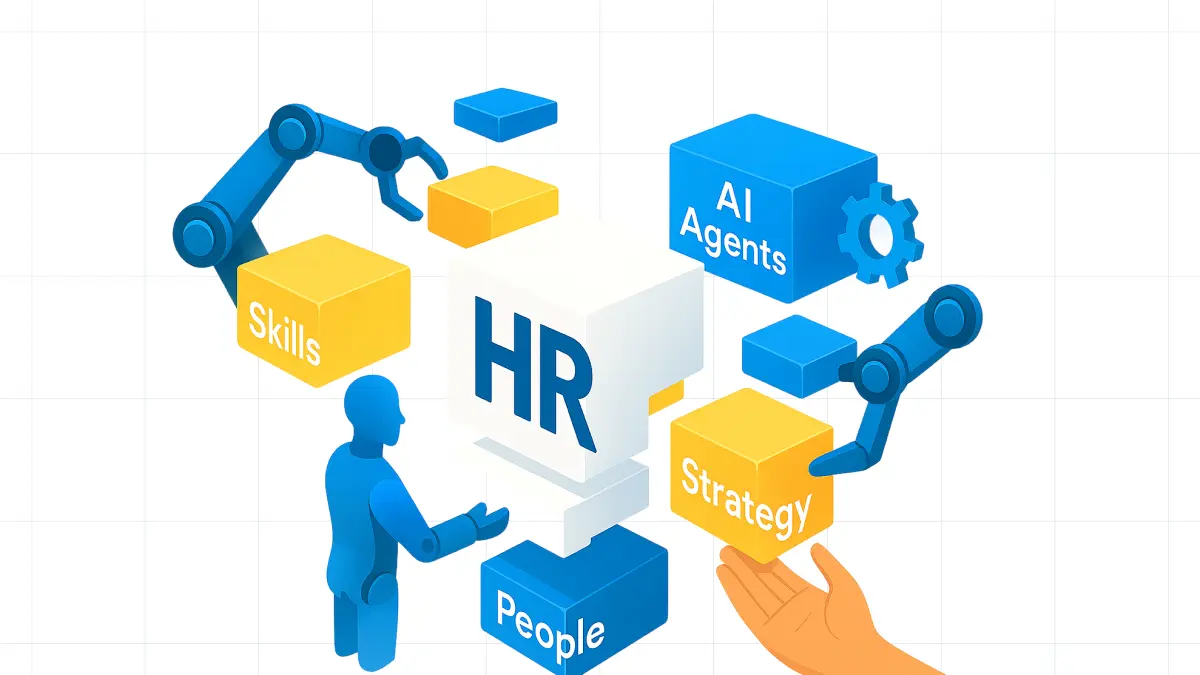Redesigning HR for the AI-Augmented Future
HR’s next evolution: from admin to architect. Learn how AI will reshape roles, strategy, and the human side of work.

As a Chief People Officer, I consistently considered the future structure of my team.
At one point, I thought about HR as product managers, considering how we run programs and how we need to build an internal go-to-market.
Now that I am in a more product- and go-to-market-focused role, I have the opportunity to view HR from the outside.
I have been thinking about the HR organization for an AI future, which will involve a combination of people and machines.
So, when you think about a future where tasks are being handled by AI or agents, where does that leave the people function?
This transformation is not merely about implementing new software or automating a few tasks.
Instead, it demands a holistic reimagining of HR functions, the acquisition of skills, the overhaul of existing workflows, and substantial changes to the very structure of organizations.
For HR to thrive in an AI-augmented environment, it must embrace AI as a pivotal tool for becoming a proactive, strategic partner within the business.
This means HR leaders must move beyond traditional practices and consider how to harness AI’s capabilities to drive long-term organizational value.
AI in HR Today
with Anthony Onesto
Subscribe for exclusive insights from Anthony Onesto, Chief People Officer at Suzy, and learn how AI is reshaping HR, enhancing employee engagement, and driving business success.
TOGETHER WITH
The Evolution of HR Roles and the Strategic Partner
The most significant and immediate impact of AI on HR is its ability to automate a wide range of time-consuming administrative tasks, including processing job applications and screening resumes, scheduling interviews, and responding to routine employee inquiries.
Through intelligent automation, HR teams will be able to free themselves from repetitive work and instead dedicate their expertise to higher-value strategic initiatives.
This shift enables HR professionals to proactively shape workforce planning, employee engagement, and talent development, reinforcing their role as indispensable business partners.
The traditional HR Business Partner (HRBP) role is undergoing a dramatic evolution, transforming from a primarily administrative and advisory function into an AI-augmented strategic partnership.
Today’s HRBPs must become fluent in predictive analytics for workforce planning, the application of AI-driven insights for talent acquisition and management, and the stewardship of organization-wide AI adoption and upskilling programs.
It is no longer sufficient to operate as a passive intermediary between leadership and employees; HRBPs must now act as catalysts for change, orchestrating the integration of human and artificial intelligence to create agile and resilient organizations.
HR is uniquely positioned to lead the reinvention of work as organizations transition into the AI-augmented era.
This responsibility encompasses not only redesigning jobs and workflows for efficiency but also reimagining roles to provide meaningful work and long-term competitive advantage.
Rather than focusing exclusively on incremental gains, HR leaders should define the new responsibilities of employees working in tandem with AI systems and clearly articulate how these positions diverge from current job descriptions.
The future of work will require positions that emphasize human strengths—such as creativity, emotional intelligence, adaptability, and complex problem-solving—while leveraging AI to handle data-intensive, repetitive, or predictive tasks.
Through thoughtful job design and transparent communication, HR can help employees navigate change, build trust in AI, and foster a culture of continuous learning and innovation.
Essential New Competencies for HR Leaders
To effectively lead this transformation, HR professionals must cultivate a diverse set of new competencies that extend well beyond conventional soft skills.
The modern HR leader must blend data-driven decision-making, advanced ethical judgment, and technological fluency.
This includes the ability to interpret complex analytics, assess and mitigate algorithmic bias, understand the basics of machine learning, and make informed decisions about the deployment of AI tools.
Additionally, HR professionals must develop strong change management skills to guide their organizations through the uncertainties of digital transformation, ensuring that both leadership and employees are engaged and empowered throughout the process.
Transitioning to an AI-augmented future is not about mass layoffs or a simplistic fire-and-hire approach.
Instead, it is fundamentally a reskill-and-elevate strategy.
HR must champion continuous learning initiatives, identifying opportunities for employees to acquire new, in-demand skills and providing resources to support their professional growth.
The modern HR professional must be conversant in the languages of business, data, and ethics.
For example, understanding how to interpret a heat map of attrition risk, evaluate an algorithm for potential bias, or design fair and transparent AI-powered assessment tools should become standard practice.
HR’s influence will increasingly depend on its ability to demystify AI for the broader workforce and ensure that all employees can thrive alongside intelligent systems.
Ultimately, the future of HR lies in leading organizational strategy rather than remaining confined to a support role.
HR’s emerging mandate is to become a visionary architect of the AI-augmented workplace—one who anticipates future business needs, proactively shapes organizational culture, and ensures that people and technology work in concert to advance enterprise goals.
The question for HR professionals is straightforward:
Are you ready to embrace this responsibility, move beyond routine administrative work, and play a central role in steering your organization through the complexities of the AI era?
AI in HR Today
with Anthony Onesto
Subscribe for exclusive insights from Anthony Onesto, Chief People Officer at Suzy, and learn how AI is reshaping HR, enhancing employee engagement, and driving business success.
